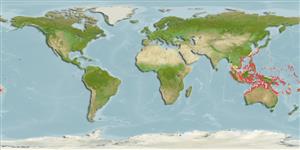>
Acanthuriformes (Surgeonfishes) >
Siganidae (Rabbitfishes)
Etymology: Siganus: Latin, siganus = a fish, rabbit fish; by the similarity of the nose (Ref. 45335).
More on author: Schlegel.
Environment: milieu / climate zone / depth range / distribution range
Ecologia
marinhas associadas(os) a recifes; intervalo de profundidade 1 - 30 m (Ref. 9710), usually 2 - 30 m (Ref. 27115). Tropical; 22°C - 27°C (Ref. 27115); 32°N - 25°S, 97°E - 174°W
Indo-West Pacific: Cocos-Keeling Islands and the South China Sea to the Gilbert Islands, north to the Ryukyu Islands, south to the southern Great Barrier Reef and New Caledonia (Ref. 37816).
Tamanho / Peso / Idade
Maturity: Lm ? range ? - ? cm
Max length : 38.0 cm TL macho/indeterminado; (Ref. 2334); common length : 25.0 cm TL macho/indeterminado; (Ref. 9813)
Espinhos dorsais (total): 13; Raios dorsais (total): 10; Espinhos anais 7; Raios anais : 9; Vértebras: 13. Body yellow-orange above to silvery white below; a prominent blackish bar on head, spotted; iris blackish; opercular area silver; dorsal and anal fin spines and rays yellow, spines with white streak. Spines stout and venomous. Preopercular angle 101°-111°. Cheeks fully covered with strong scales. Midline of thorax scaled; scaled pelvic ridges may interrupt scale row pattern. Low rim of anterior nostril expanded posteriorly into a short, broad triangular flap.
Occurs in shallow, coral-rich areas of clear lagoons and seaward reefs. Individuals up to 7 cm SL forms large schools in shallows, lagoons and outer reef flats, particularly in areas dominated by luxurious growths of Acropora. Adults occur in pairs. Juveniles feed on filamentous algae, adults on algae, tunicates, and sponges (Ref. 9813, 48637). Can inflict painful stings (Ref. 4690).
Ciclo de vida ou comportamento de acasalamento
Maturidade | Reprodução | Desova | Ovos | Fecundidade | Larvas
Woodland, D.J., 1990. Revision of the fish family Siganidae with descriptions of two new species and comments on distribution and biology. Indo-Pac. Fish. (19):136 p. (Ref. 1419)
Status na Lista Vermelha da UICN (Ref. 130435)
Uso pelos humanos
Pescarias: pouco comercial; Aquário: Espécies comerciais
Mais informação
ReferênciasAquaculturaPerfil para aquaculturaEstirpesGenéticaElectrophoresesHereditariedadeDoençasProcessamentoNutrientsConversão de massa
Ferramentas
Relatórios especiais
Baixar XML
Fontes da internet
Estimates based on models
Preferred temperature (Ref.
123201): 24.7 - 29, mean 27.7 °C (based on 722 cells).
Índice de diversidade filogenética (Ref.
82804): PD
50 = 0.5000 [Uniqueness, from 0.5 = low to 2.0 = high].
Bayesian length-weight: a=0.01230 (0.00706 - 0.02143), b=2.98 (2.83 - 3.13), in cm total length, based on LWR estimates for this species & Genus-body shape (Ref.
93245).
Nível Trófico (Ref.
69278): 3.0 ±0.00 se; based on food items.
Resiliência (Ref.
120179): Elevada, tempo mínimo de duplicação da população menor que 15 meses (Preliminary K or Fecundity.).
Fishing Vulnerability (Ref.
59153): Low to moderate vulnerability (28 of 100).
Nutrients (Ref.
124155): Calcium = 34.8 [16.6, 77.5] mg/100g; Iron = 0.646 [0.310, 1.327] mg/100g; Protein = 19.3 [18.0, 20.7] %; Omega3 = 0.144 [0.081, 0.258] g/100g; Selenium = 20 [9, 45] μg/100g; VitaminA = 52.5 [21.1, 132.1] μg/100g; Zinc = 1.23 [0.51, 2.40] mg/100g (wet weight);
